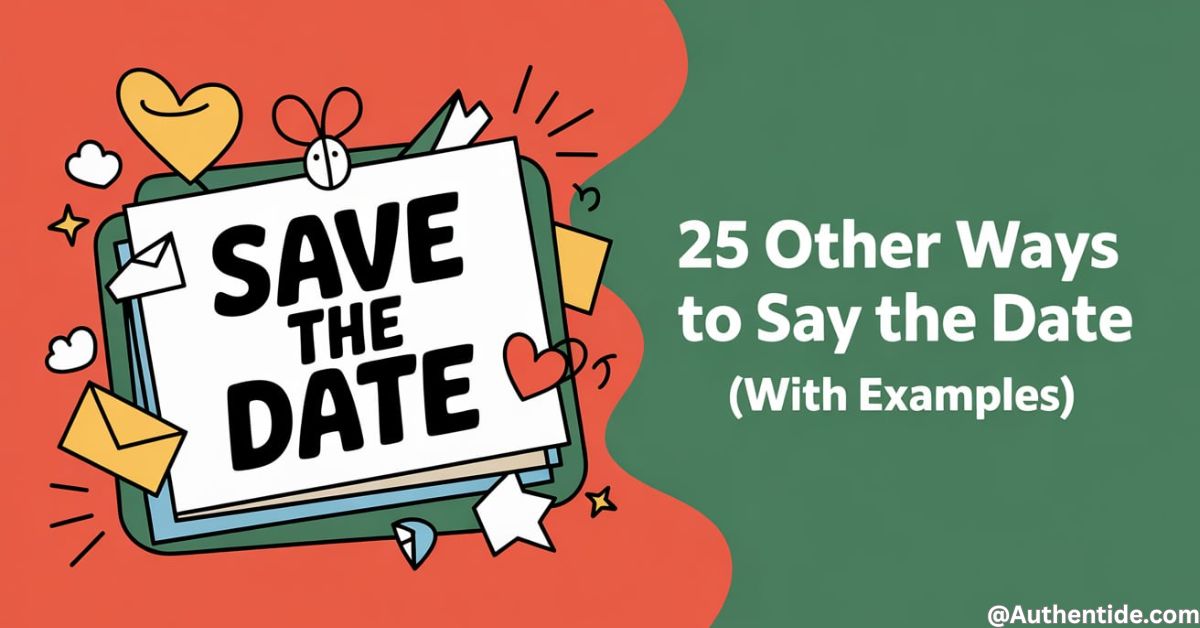Save the date announcements have become an essential part of event planning, but the traditional phrase can sometimes feel overused or not quite right for your particular occasion. Whether you’re planning a wedding, corporate event, or casual gathering, finding fresh alternatives to “save the date” can make your invitation stand out and better reflect the tone of your event.
The art of asking someone to reserve time on their calendar goes beyond mere scheduling it is about creating anticipation and conveying the importance of their presence. Each alternative phrase carries its own subtle meaning and energy, from the formal reserve-the-date approach that suggests elegance to the casual lock-it-in that brings a sense of fun and certainty.
In today’s busy world where digital calendars fill up quickly and time is our most precious resource, how you ask someone to prioritize your event matters. This comprehensive guide explores 25 creative alternatives to the standard save the date wording, complete with real-world examples that you can adapt for any occasion. From professional business settings to intimate celebrations, you’ll find the perfect phrase to ensure your important day gets the attention it deserves.
is it Professional to Say: “Save the Date”
“Save the Date” is generally considered professional and appropriate for most formal occasions. It’s widely recognized in business and social contexts as a standard phrase that clearly communicates the need to reserve time for an upcoming event.
While it works well for corporate functions, weddings, and conferences, some settings might benefit from alternatives that better match specific professional tones or organizational cultures. Ultimately, it’s an efficient, straightforward phrase that gets the message across without confusion.
What to Say Instead of “Save The Date”
- Mark Your Calendars (Friendly and Informal)
- Reserve the Date (Formal and Commitment-Oriented)
- Don’t Make Other Plans (Direct and Emphatic)
- Put It on Your Schedule (Organized and Professional)
- Circle the Date (Casual and Inviting)
- Lock It In (Confident and Assured)
- Clear Your Calendar (Urgent and Important)
- Block Off the Day (Comprehensive and Thorough)
- Set a Reminder (Practical and Tech-Savvy)
- Make a Note of It (Attentive and Considerate)
- Hold the Date (Polite and Traditional)
- Pencil Us In (Flexible and Light-hearted)
- Save This Spot (Unique and Memorable)
- Earmark the Evening (Sophisticated and Specific)
- Flag This Date (Attention-Grabbing)
- Claim Your Spot (Creates Urgency)
- Add to Your Agenda (Professional and Structured)
- Remember This Day (Emotional and Meaningful)
- Keep This Time Open (Considerate and Flexible)
- This Date is Taken (Playful and Definitive)
- Get Ready For (Builds Excitement)
- Jot It Down (Casual and Action-Oriented)
- Ink It In (Committed and Definite)
- Highlight Your Calendar (Visually Descriptive)
- Count Down To (Creates Anticipation)
Why Consider Alternatives to “Save the Date”?
Before diving into our list of alternatives, let’s understand why you might want other words for save the date in the first place.
The phrase “save the date” has become so common that it risks blending into the background noise of daily communications. By choosing alternative wording, you can:
- Personalize your message to match the tone and theme of your event
- Stand out in a crowded inbox or mailbox
- Better reflect your personality or brand voice
- Appeal to different audiences with language that resonates with them
- Create stronger excitement through fresh, unexpected phrasing
Now, let’s explore 25 creative alternatives that will help your invitation make an impact!
25 Alternatives to “Save the Date” with Examples
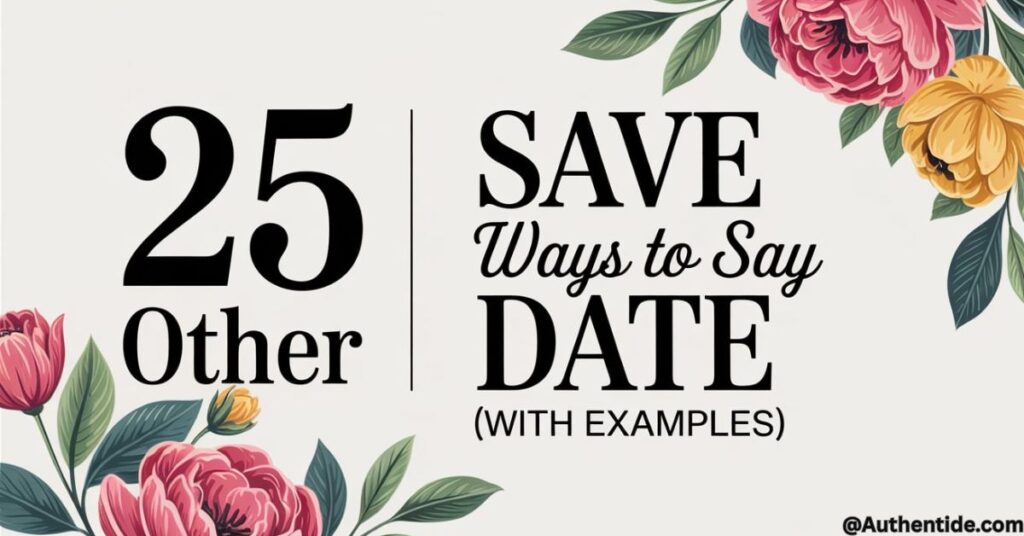
Here are 25 Alternatives to “Save the Date” with Examples:
1. Mark Your Calendars (Friendly and Informal)
This alternative works beautifully for casual events, family gatherings, or community functions. It has a friendly, approachable tone that doesn’t pressure recipients.
Example: “Mark your calendars for July 15th! Tom and Sarah’s annual summer barbecue is back and bigger than ever. We’ve secured the community park pavilion, ordered twice the food, and have games planned for all ages. Looking forward to seeing everyone there!”
2. Reserve the Date (Formal and Commitment-Oriented)
When planning upscale events like galas, formal weddings, or significant corporate functions, “reserve the date” adds a touch of elegance and importance.
Example: “The Johnson Foundation cordially asks you to reserve the date of October 12th, 2025, for our Annual Charity Gala. This year’s event will be held at the Grand Metropolitan Hotel and will feature a special performance by the City Symphony Orchestra. Formal invitations with additional details will follow in August.”
3. Don’t Make Other Plans (Direct and Emphatic)
This straightforward alternative works well for close friends and family when you want to emphasize the importance of attendance.
Example: “Don’t make other plans for September 3rd! After five years of dating and two postponed proposals, James is FINALLY popping the question to Melissa at a surprise engagement party. Your presence is essential to make this moment unforgettable for her. Absolute secrecy required!”
4. Put It on Your Schedule (Organized and Professional)
Perfect for business events, workshops, or professional development opportunities when communicating with colleagues.
Example: “Dear Marketing Team, Please put it on your schedule — our Q4 planning retreat is set for November 8-10 at Mountain View Resort. This three-day intensive will shape our strategy for the coming year. Calendar invites with the agenda will be distributed next week. Attendance is mandatory for all department heads.”
5. Circle the Date (Casual and Inviting)
This nostalgic phrase evokes the image of physically marking a calendar, making it perfect for school events, reunions, or community gatherings.
Example: “Attention Class of 2015! Circle the date June 25th for our 10-year reunion! We’ve rented out The Old Gymnasium for a night of reminiscing, reconnecting, and recreating some of our favorite high school memories (minus the drama). Early bird tickets available now through the link below.”
6. Lock It In (Confident and Assured)
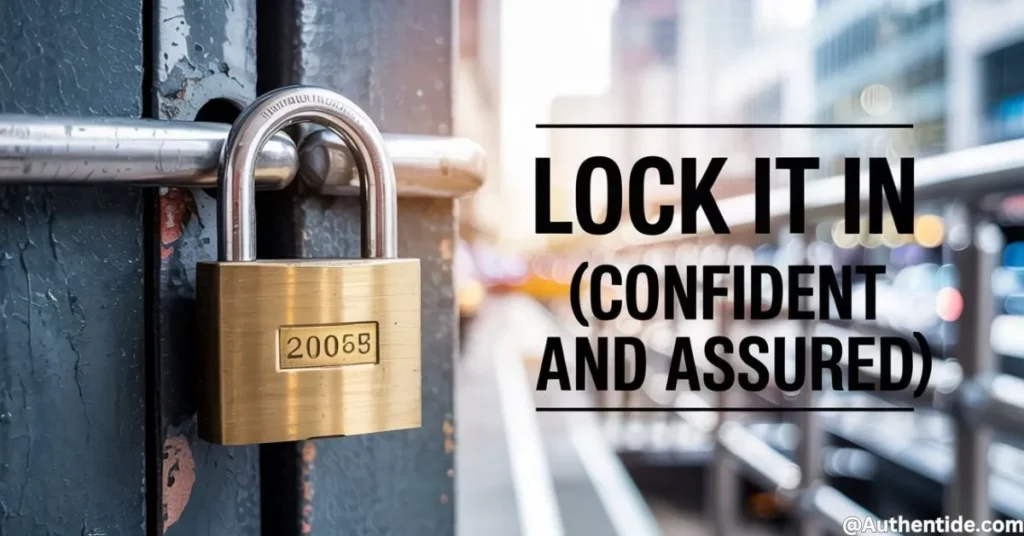
This modern, decisive phrase works well for younger audiences and casual events with a confirmed date.
Example: “Hey festival crew! Time to lock it in — August 5th is our day at SummerSounds Music Festival! I’ve already purchased a block of 15 tickets at the group rate. First come, first served, so hit the group chat with your commitment ASAP. Payment due by June 1st!”
7. Clear Your Calendar (Urgent and Important)
When you need to communicate that your event takes priority, this phrase helps convey the significance without being too formal.
Example: “Clear your calendar for December 8th! After 25 years of service, Dr. Emily Zhang is retiring, and we’re throwing her the celebration she deserves. As her closest colleagues and friends, your stories and presence will make this evening special. Details under wraps — she reads these emails!”
8. Block Off the Day (Comprehensive and Thorough)
Use this when your event will require the entire day or significant time commitment.
Example: “Team Leaders — Please block off the day on February 15th for our annual strategic planning session. We’ll start with breakfast at 8 AM and continue through dinner. This year’s focus: restructuring our customer experience journey. Please come prepared with department data and prepared to contribute substantially.”
9. Set a Reminder (Practical and Tech-Savvy)
This works well for digital communications where recipients can literally click to add to their digital calendars.
Example: “Set a reminder for Virtual Book Club: April 18th at 7 PM EST. We’ll be discussing ‘The Midnight Library’ by Matt Haig. Click the link below to automatically add this event to your digital calendar and receive the Zoom link. Don’t forget to finish the book beforehand!”
10. Make a Note of It (Attentive and Considerate)
This gentle suggestion works well for preliminary announcements when details are still being finalized.
Example: “Please make a note of it — the Peterson-Williams wedding will be held the weekend of May 22nd in Charleston, SC. We’re finalizing venue details and will send complete information in our formal invitation. We’re sharing this early so our out-of-town guests can begin making travel arrangements.”
11. Hold the Date (Polite and Traditional)
This alternative carries a slightly more formal tone than “save the date” while conveying the same message.
Example: “The Board of Directors requests that you hold the date for our Annual Shareholders Meeting on March 17th. This year’s meeting will include critical votes on the proposed merger and introduction of our new executive team. Official notices will be mailed as required by bylaws.”
12. Pencil Us In (Flexible and Light-hearted)

Perfect for early planning stages when you want people aware but details might still change.
Example: “Hey theater lovers! Pencil us in for July 9th — the Community Players’ summer production of ‘A Midsummer Night’s Dream’ opens that evening. We’re still confirming whether we’ll do a pre-show dinner, but wanted to get this on your radar. Group ticket discount available if we have at least 10 people!”
13. Save This Spot (Unique and Memorable)
This fresh alternative creates a spatial metaphor that can stand out in communications.
Example: “Save this spot on your calendar: September 30th, 2025, for TechCon Midwest! After last year’s sellout event, we’re moving to the larger Convention Center downtown. Early registration opens in April with special pricing for previous attendees. Don’t miss what’s becoming the region’s premier tech gathering!”
14. Earmark the Evening (Sophisticated and Specific)
Use this when you’re planning an evening event with a refined atmosphere.
Example: “The Arts Council invites patrons to earmark the evening of November 5th for our Fall Gallery Opening. This exclusive preview will feature works from emerging regional artists, accompanied by wine selections from local vineyards. Patron-level members receive priority admission at 6 PM.”
15. Flag This Date (Attention-Grabbing)
This visual metaphor works well in email subject lines or when you need something to stand out.
Example: “Attention all Department Managers: Flag this date in your planning systems. January 12th is the deadline for all annual budget submissions. The finance team has scheduled drop-in review sessions the week prior. Sign up for a slot via the scheduling link attached.”
16. Claim Your Spot (Creates Urgency)
Perfect for events with limited capacity where you want to encourage prompt responses.
Example: “Ready to learn master-level photography skills? Claim your spot for October 8-10 — renowned photographer Eliza Chen will be leading an exclusive weekend workshop limited to just 15 participants. The last two workshops sold out within 48 hours, so don’t delay if you’re interested!”
17. Add to Your Agenda (Professional and Structured)
This works well in business settings when communicating with clients or partners.
Example: “Dear Valued Client, Please add to your agenda our upcoming Client Appreciation Event on June 7th. This year’s theme is ‘Innovation in Action’ and will include previews of our upcoming service enhancements. Your account manager will follow up with specific timing for your personalized product demonstration.”
18. Remember This Day (Emotional and Meaningful)
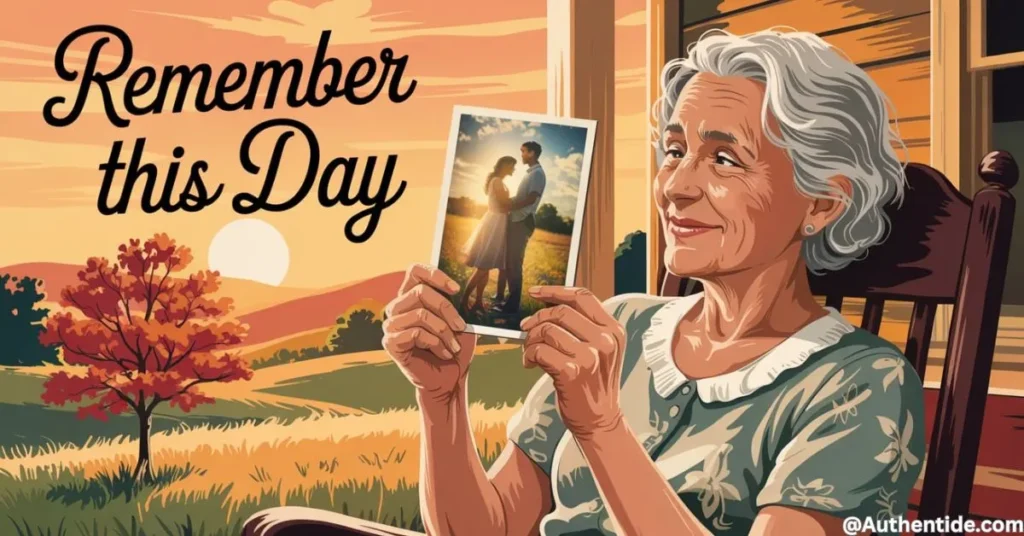
Use this for once-in-a-lifetime events that hold special significance.
Example: “Remember this day — August 21st — when after 50 wonderful years together, my grandparents Robert and Eleanor will renew their vows in the same church where they first said ‘I do’. Family dinner to follow at their home. No gifts please, just your presence and perhaps a written memory to add to their anniversary book.”
19. Keep This Time Open (Considerate and Flexible)
This phrasing acknowledges the value of people’s time while requesting they prioritize your event.
Example: “Hi everyone, Please keep this time open for our department’s quarterly volunteer day on March 3rd. We’re finalizing arrangements with either the Food Bank or the Animal Shelter based on their needs. Your preference? Reply to this email and we’ll try to accommodate the majority vote!”
20. This Date is Taken (Playful and Definitive)
A fun way to announce a date that’s been claimed for a special purpose.
Example: “Attention friends and family: This date is taken! May 30th, 2025, is officially the day Samantha and Daniel will tie the knot! Mountain destination wedding details coming soon, but start thinking about your hiking boots and fancy clothes combo — this celebration will be uniquely us!”
21. Get Ready For (Builds Excitement)
This forward-looking phrase helps create anticipation for your event.
Example: “Fitness enthusiasts, get ready for July 22nd! CrossFit Champion Maya Reynolds will be hosting a special training session at our gym. This three-hour workshop will focus on proper form and technique modifications. Space limited to ensure personal attention. Member pre-registration begins next Monday.”
22. Jot It Down (Casual and Action-Oriented)
This works well for informal communications with friends or close colleagues.
Example: “Quick note to the neighborhood watch group — jot it down that we’re moving our monthly meeting to August 18th due to the community center renovations. We’ll meet at the library’s conference room instead. Officer Rodriguez will be joining us to discuss the new community alert system.”
23. Ink It In (Committed and Definite)
Suggests a higher level of commitment than “pencil it in” — use when the date is fixed.
Example: “Team Captains: Ink it in — the championship tournament is scheduled for October 1-3 at Regional Sports Complex. This date is confirmed with the venue and officials. Team registration fees due by September 1st. Start organizing your practice schedules accordingly!”
24. Highlight Your Calendar (Visually Descriptive)
Creates a vivid image while emphasizing the event’s importance.
Example: “Book lovers, highlight your calendar for April 15th! Bestselling author Jordan Adams will be at City Bookshop signing copies of her latest thriller. We’ll have an exclusive Q&A session for the first 50 attendees, plus wine and appetizers. Pre-purchase the book for guaranteed entry.”
25. Count Down To (Creates Anticipation)
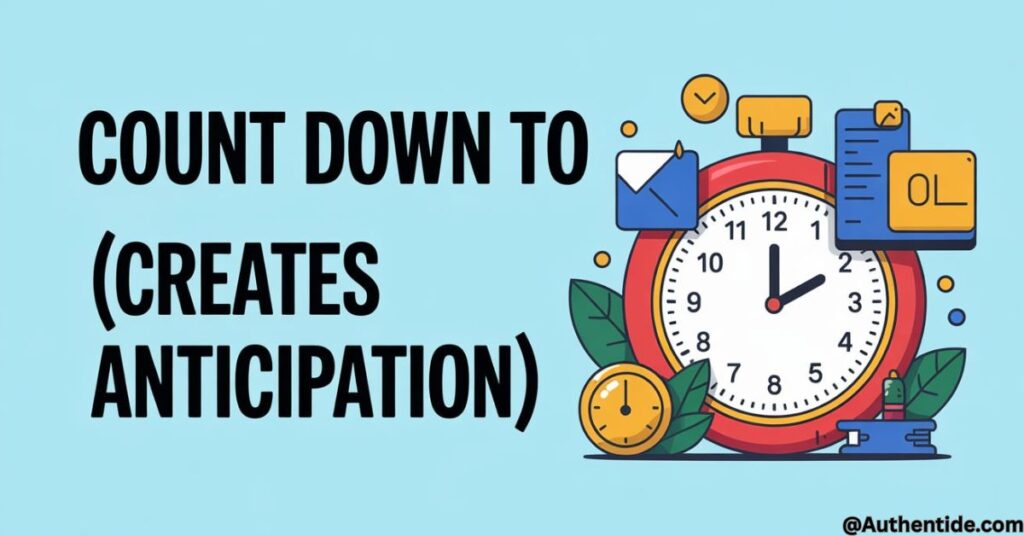
This forward-looking phrase works especially well for milestone events or celebrations.
Example: “Start the count down to December 31st! This year’s New Year’s Charity Gala promises to be our most spectacular yet. With a ‘Roaring 20s’ theme, live jazz band, and silent auction featuring luxury items, you won’t want to miss ringing in the new year while supporting children’s literacy programs.”
How to Choose the Right Alternative for Your Event
The perfect save the date alternative depends on several factors:
- Event formality: Business meetings and formal weddings call for more traditional phrasing like “reserve the date” or “hold the date,” while casual gatherings allow for playful options like “ink it in” or “lock it in”
- Your relationship with recipients: Close friends might appreciate the direct “don’t make other plans,” while acquaintances or business contacts would respond better to “we hope you can join us”
- Event urgency: Time-sensitive or high-demand events might benefit from phrases like “claim your spot” or “clear your calendar” to emphasize importance
- Communication medium: Email subjects might work better with concise phrases, while printed cards can accommodate more elaborate wording
Pro Tips for Effective Date Announcements
When crafting your event invitation using alternatives to “save the date,” keep these professional tips in mind:
- Be clear about the date format to avoid confusion. For international audiences, spelling out the month (June 15, 2025) prevents misunderstandings about day/month order.
- Include the day of the week along with the date. “Saturday, October 8th” helps people immediately contextualize the event without checking their calendar.
- Specify time commitment when possible. “Evening of,” “All day,” or specific hours helps recipients properly block their time.
- Follow up appropriately. Most save-the-date notices should be followed by a formal invitation with complete details closer to the event date.
- Match your tone to your event. The wording should give recipients a preview of what to expect—formal, fun, professional, or casual.
- Consider cultural and regional differences in how announcements are perceived. Some phrases may carry different connotations in different communities.
- Provide enough advance notice appropriate to your event type. Destination weddings might require 8-12 months notice, while office parties might need just a few weeks.
Digital vs. Physical Date Announcements
When deciding between digital and physical save the date alternatives, consider:
Digital Advantages:
- Immediate delivery with no printing or mailing delays
- Interactive elements like calendar integration or RSVP links
- Cost-effective for large guest lists
- Environmentally friendly compared to paper options
- Easy updates if details change
Physical Advantages:
- More memorable and tangible reminder
- Shows additional effort and formality
- Design opportunities for creative expression
- Better for less tech-savvy recipients
- Can become keepsakes for significant events
Common Questions About Save the Date Alternatives
When should I send out date announcements?
For major events like weddings, 6-8 months in advance is customary, especially if travel is involved. For business events, 4-6 weeks is often sufficient. Social gatherings might only need 2-3 weeks notice.
Is it necessary to send a formal invitation after the save the date?
Yes, for most formal events. The save the date establishes the day, while the invitation provides specific details about time, location, dress code, and other important information.
Can I use humor in my date announcement?
Absolutely, if it fits the occasion and your audience! Humorous wording can make your announcement memorable, but ensure the actual date and basic details remain clear.
Should I include registry information with the save the date?
Generally, no. Save the date notices should focus solely on announcing the date. Registry information is more appropriate for the formal invitation or wedding website.
Conclusion
Moving beyond the standard “save the date” phrasing opens up creative possibilities to better reflect your event’s personality and importance. Whether you choose to “mark your calendars” or “ink it in,” the right alternative can set the tone for your occasion while ensuring your guests prioritize your special day.
Remember that the purpose of any date announcement is simple: to ensure the people you want to attend can plan accordingly. Choose the wording that best communicates the significance of your event while respecting your relationship with the recipients.
With these 25 alternatives and examples, you’re well-equipped to create date announcements that stand out, get noticed, and most importantly, get added to calendars!

Your go-to place for smart synonyms and celebrity updates. Muhammad Hassan Abid is dedicated to creating useful, engaging content that informs, inspires, and truly serves your curiosity

